Birthmarks (moles) are formations on the skin that many people do not pay attention to. And they are only interested in them if another mole is suddenly discovered on the body. What does the process of the emergence of new birthmarks indicate, and does it pose a health hazard?
What are birthmarks
Moles, or, as doctors say, nevi, are accumulations of special cells – melanocytes – in the layers of the skin. The purpose of melanocytes is to produce the pigment melanin, which protects the skin from harmful ultraviolet radiation. Normally, most melanocytes are located between the top layer of skin - the epidermis and the middle layer - the dermis. Melanocytes are usually distributed evenly over the surface of the skin. However, this does not always happen. Irregularities in the distribution of melanocytes lead to the formation of birthmarks.
Moles are usually dark or brown in color. Less commonly, almost black nevi can occur. Blue or purple moles are also observed.
Nevi are usually evenly colored, although on their surface there may be single darker and lighter areas compared to the background. A typical mole is round or oval in shape and has a diameter of no more than 5 mm. Moles larger than 10 mm are called giant. There are also birthmarks of irregular shape and uneven color - dysplastic nevi.
The most dangerous type of mole is a dysplastic nevus.
Nevi are also divided into intradermal and epidermal - depending on the depth of the accumulation of melanocytes.
Moles can be located on any part of the body. There are a lot of them on the arms, torso, and neck. However, most often (relative to the unit area) moles are found on the face. Moles can also form on mucous membranes, although this is rare.
Usually nevi do not protrude above the skin level. However, there are also protruding (convex) moles.
Lentigo and freckles
There is also a type of skin spots called lentigo. They are usually larger in size than a typical nevus, but also have a less intense, pale brown color and less clear boundaries. Their appearance is also associated with increased melanin production.
Another type of melanin-containing spots are freckles. Lentigines are most often observed in adults and the elderly, freckles - in children and adolescents. Lentigines and freckles are not usually classified as moles, although they have a similar origin.
Angiomas
Angiomas are also often classified as moles. These are red, slightly raised formations on the skin that are vascular in nature. If you press on such a formation, it will turn pale and then return to its original color. This is explained by the fact that angiomas consist of many tiny vessels. The mechanism of their occurrence is also not fully understood. Only one thing is clear - unlike ordinary moles, their occurrence is in no way connected with genetic reasons. Vascular moles have a relatively low risk of malignant transformation.
Angioma – vascular mole
When and who gets moles?
Although nevi are popularly called birthmarks, in fact, most moles are not present in a person from birth, but appear much later, throughout life. 99% of children are born with an absolutely clean body, devoid of age spots. And the first birthmarks appear in babies in the first or second year. However, these moles are so small that they are often simply not noticed.
Most moles appear on the body during adolescence and before the age of 25. This feature is associated with the intensive production of sex hormones during this period. And old moles may increase slightly or change color during puberty.
However, even in adults, age spots can occur from time to time. And some spots can also disappear spontaneously. The total number of moles can reach hundreds, although usually there are much fewer of them - no more than a dozen. There are also people who have almost no moles. Women usually have more birthmarks than men. Light-skinned people also have more moles than dark-skinned people.
Thus, the appearance of new moles in various parts of the body is a process that is a normal phenomenon in the body. Usually it is not associated with any pathologies. Of course, if the number of moles does not exceed a reasonable limit. And the birthmarks themselves look standard and do not cause discomfort.
Causes of birthmarks
The reason for the appearance of new birthmarks on the body is largely unclear. What is known is that the amount of melanin in the body is regulated by melanotropic hormone produced by the pituitary gland. Consequently, if a new mole appears on the body, this fact is often a consequence of increased levels of this hormone.
What phenomena affect the level of melanotropic hormone? First of all, such factors include an imbalance in the endocrine system. In women, this condition occurs during pregnancy and childbirth, in the period preceding menopause. Women are more likely to experience hormonal changes. Perhaps this circumstance is the reason for the more frequent appearance of birthmarks in women.
In men, this process can be triggered by diseases or injuries of the testicles, resulting in increased estrogen production. Also, the reasons for fluctuations in the level of melanotropic hormone can be:
- stress,
- serious illnesses,
- pathology of the pituitary gland,
- viral infections.
Insect bites and abrasions are another possible cause of moles. This circumstance is due to the fact that wounds can get infected, which often leads to local accumulation of melanin.
New moles can also appear after exposure of the skin to ultraviolet rays. Exposure to sunlight or other ultraviolet sources is accompanied by an increase in the level of melanin in the skin and the release of melanocytes to the surface. The sun's rays can not only lead to the appearance of new nevi, but also to the enlargement or degeneration of old ones. It is possible that other types of radiation, such as x-rays, contribute to the appearance of moles on various parts of the body. Such radiation can affect the body, for example, during medical procedures.
The causes of angiomas are dysfunction of the liver, intestines, and pancreas.
What to do if new birthmarks appear?
If one or two moles appear on the body in a place where there were none before, this is not yet a cause for concern. True, here you need to pay attention to the shape, color, size of the spot and accompanying symptoms. If the mole has the correct shape and uniform color, does not hurt, is not inflamed and does not bleed, then most likely it does not pose a danger. But a change in shape, color or increase in existing moles should be alarming.
If there are reasons for concern, or the nature of the formation is unclear, you should immediately consult a dermatologist. The fact is that some birthmarks can turn into malignant tumors - melanomas. The greatest danger is represented by dysplastic nevi. Although this happens infrequently, it still doesn’t hurt to be on the safe side. The main thing to remember is that you should not touch the mole or try to remove it yourself. This can lead to dire consequences.
Removal of common nevi is usually not indicated. The only exceptions are moles that protrude from the skin, the risk of injury to which is very high, moles that create psychological discomfort in the patient, as well as dysplastic nevi.
Why can there be many moles on the body, and are they dangerous?
The abundance of nevi in itself is not dangerous to health. However, they need to be closely monitored and regularly examined by a dermatologist. A doctor's examination is also required after a holiday in the southern resorts. Regular self-examination of the body is also necessary. If a new birthmark of an unusual shape appears on the body, or an old one has quickly grown and changed its shape, size and color, you should immediately consult a doctor.
Numerous moles on the body
People with an abundance of moles on their skin should remember that the sun is not only a friend, but also an enemy. The danger comes from the ultraviolet rays contained in the radiation of the star closest to us. When they come into contact with pigmented areas of the skin, they can cause their malignant degeneration. Therefore, it is necessary to limit the duration of sunbathing. In summer, you should not sunbathe during the most dangerous hours in the middle of the day, when the largest amount of hard UV rays reaches the Earth. And in a situation where the sun's rays fall on bare skin for a long time, it is necessary to use sunscreen to protect the body. Recently, there has been a thinning of the ozone layer in the atmosphere. This results in increased intensity of UV rays. It has also been established that people with pale skin are more susceptible to the negative effects of radiation than people with dark skin.
If a person has many nevi on his skin, then often only his genes can be to blame. It is known that the tendency to the abundant appearance of nevi can be inherited. Also, the appearance of moles is to some extent evidence of the biological processes of aging. Although, on the other hand, there is a theory that the abundance of moles reduces biological age by several years, and moles themselves are a protective factor for the body. According to popular belief, moles are a symbol of longevity and promote good luck. But another fact has been proven - the abundance of nevi increases the likelihood of developing skin cancer.
Moles are benign formations on human skin. The localization of such neoplasms can be very diverse: they can be located on any part of the body and face. If you notice that you have many new moles on your body, then there is no need to panic. From this article you will learn about the reasons for the appearance of moles on the body, as well as their meaning.
Warning: mole
All pigmented moles are considered benign neoplasms and in 90% of cases, they never degenerate into something more terrible. However, it is worth protecting them from damage and exposure, including exposure to the sun. You should pay attention to the following points if:
- suddenly many moles appeared on the body.
- the edges of the nevus become uneven;
- the color of the spot changes;
- the mole quickly grows in width or upward;
- the skin on it cracks, hurts, itches.
Laser mole removal is fairly safe. But doctors believe that if a mole does not bother you and sits tightly on the body, then it is better to leave it alone. Moles are often removed on the collarbones, where they can be easily torn off or rubbed by a bra strap or handbag, as well as on the arms, legs, and lower back.
To reduce the risk of nevi degenerating into cancerous tumors, after 30 years of age, limit trips to the solarium and try to spend less time in the open sun. Sunscreen is required before going to the beach and after swimming. Cosmetics with ultraviolet filters will prevent the appearance of moles on the face in winter.
What is a mole
A mole is a pigmented formation on the skin. It occurs by overcrowding cells with melanocytes. In other words, a mole appears in a place where the accumulation of melanocytes is too high. The medical name for a mole is nevus. Nevus is absolutely not dangerous, since it is a benign formation.
If you notice any unusual changes, it is best to consult a dermatologist immediately. Sometimes a mole can develop into a malignant one, but this is very rare. This formation is called melanoma. This is a type of cancer that develops very rapidly and has quite serious consequences.
Why moles appear
Most moles appear at the age of 10 years. There are cases when a child is born with moles. This is a rare but completely normal occurrence. It is believed that moles appear during the period of hormonal changes in the body.
Women are more susceptible to hormonal changes than men. This is why females have more moles. Also, women often have moles on the mucous membranes. Moles may appear during pregnancy, and this is quite normal.
The appearance of moles is very common in pregnant women. Most mothers in this case run to the hospital for help or look for salvation on the Internet or reference books. To solve the problem, it is enough to find out what a mole is and why they appear.
Factors contributing to the appearance of new moles
It must be said that there are people whose bodies are covered with many moles. There are others who have virtually no moles. Newly born babies do not have pigmentation, and only with age, usually in the second year of life, moles appear. Nobody usually pays attention to the first moles - they are so invisible.
At the age of puberty, new moles appear. For some people, old moles only change during a hormonal surge. The increase in the number of moles is influenced by changes occurring in the body. In addition, moles can change color, size, become darker or brighter.
Pregnancy can also provoke the appearance of new moles. Direct sunlight contributes to the appearance of moles on the body.
What is a mole
A mole is a pigmented formation on the skin. It occurs by overcrowding cells with melanocytes. In other words, a mole appears in a place where the accumulation of melanocytes is too high. The medical name for a mole is nevus.
Nevus is absolutely not dangerous, since it is a benign formation. If moles on the skin do not bother or cause discomfort, then there is nothing wrong with it. Even if there are very large numbers of moles on the body. If a mole suddenly begins to grow, itch, bleed, or change color, then this should alert you. If you notice any unusual changes, it is best to consult a dermatologist immediately. Sometimes a mole can develop into a malignant one, but this is very rare. This formation is called melanoma. This is a type of cancer that develops very rapidly and has quite serious consequences.
Interesting and important facts
When a woman is pregnant, she experiences a crazy surge of hormones during lactation. This is a consequence of the fact that during pregnancy the body works for two, which is a lot of work for it. Hormones that are produced in double volume come to the rescue. This helps to cope with the load. The appearance of moles during pregnancy indicates that the hormonal system is working perfectly. Sometimes nevi disappear after a while, but this is not a reason to panic. More often than not, they last a lifetime and remind you of a wonderful time in your life.
It is worth paying attention if moles that appear during pregnancy begin to bother you. In principle, this applies not only to new but also to old formations. If you notice a change in color, swelling, itching or burning, consult a specialist immediately. This often happens in pregnant women due to hormonal explosions. After childbirth, everything falls into place. Such places must be carefully monitored so as not to cause harm. Try to avoid exposure to ultraviolet rays on these areas, do not scratch or press.
A specialist will help you understand the cause of discomfort. Alternatively, your doctor may suggest removing the mole to avoid the risk of developing melanoma. But this is already an extreme case. Often, pregnant women develop moles, but most often doctors do not remove such formations so as not to bother the mother and baby.
Why are there many moles on the body?
There are several reasons, and each of them is expressed in the characteristics of the human body. Such factors as astrology, esotericism, and the character of a person have absolutely nothing to do with it. Just an organism. So, most often people who have fair skin have a lot of moles. It contains a little melanin, and it does not spread throughout the skin, but is concentrated at certain points.
They are pigment spots. The second reason for the prevalence of moles is liver disease. At the same time, it is not necessary for the liver to hurt: it can be destroyed completely unnoticeably. The third significant reason is the incorrect distribution of human energy. If he is angry too much or, conversely, sad too little, being constantly cheerful and welcoming, his energy meridians are disrupted, causing moles to appear on the skin for the first time already in a person’s conscious age. These, in fact, are all the possible reasons for the massive appearance of birthmarks.
What does the appearance of new moles mean?
Moles are considered benign formations, regardless of whether they are congenital or acquired. But what is the reason for the appearance of new moles? Sometimes it is simply impossible to understand this issue - it is so difficult to trace the factor that provoked the appearance of the tumor. In any case, if you have a lot of moles on your body, there is no need to panic.
However, it is known that there are no places on the body where a new mole cannot appear, including the mucous membranes.
The appearance of new moles does not necessarily indicate the presence of a symptom of their malignant degeneration. In fact, the latter does not depend on quantity, but depends on condition. If a mole has changes - redness, swelling, hardening, soreness, itching, change in shape - these symptoms may be a cause for concern. In most cases, the transformation of a mole into melanoma, that is, into a malignant mole, occurs due to the fault of its carrier: for example, a person accidentally injured it, or constantly removed hair from the mole, etc.
Why did a red mole appear?
A red mole consists of many microscopic vessels. It can appear, as a rule, on any part of the body. Most often, red moles occur in young children and adolescents. Perhaps because it is in childhood that the human circulatory system undergoes certain changes. Often, red moles appear on the body of adults after prolonged exposure to the sun. They can be located in different layers of the skin and in different parts of the circulatory system: arterial, capillary or venous. Treatment depends on the location of the moles.
There is no need to worry about the appearance of red moles. Most of them can appear quickly and disappear just as quickly. Only a non-standard, rapidly growing mole that changes color can be a cause for concern.
In medicine, a red mole is called an angioma. It belongs to the category of safe skin diseases. Currently, the appearance of red moles has not been fully studied and there are only assumptions as to the main reason for their origin. A red mole has one main feature: when lightly pressed on it, it becomes pale, and then returns to its original natural color.
It is believed that the cause of the appearance of red moles on the body of an adult may be hormonal changes occurring in the body.
Therefore, if a red mole appears on your body, you should think about a preventative visit to the doctor. Perhaps the alarm will turn out to be false, but in cases with your own health, it is always worth being on the safe side. Also, the cause of the appearance of a red mole may be excessively intense work of blood vessels, or a deviation in the functioning of pigment cells responsible for skin pigmentation.
Many moles - is it good or bad?
In fact, there is nothing good about having too many moles. There are many legends that: a person who has many birthmarks will become happy; such a person is spiritually multifaceted and intellectually gifted; moles attract good luck and repel bad luck... There are a lot of options, but all of this is just wishful thinking. In fact, there is nothing good about a large number of moles. On the contrary, British scientists have recently proven that an abundance of age spots doubles the risk of developing skin cancer for their carrier.
The same pair of genes in the human body is responsible for both the formation of moles and the risk of developing cancer. People who do not have a large number of birthmarks do not have a trace of any of these genes. Thus, you need to fight the abundance of moles, so to speak, from the inside.
However, they have one advantage. Quite a dubious plus, I must say, but scientists seem to have proven it. The fact is that a huge number of birthmarks have a beneficial effect on a person’s biological age, reducing it by 5-7 years. As a result, people with nevi are more active and internally young. Even if this theory has a scientific basis, it is unlikely that its results should be taken as an axiom. It is unlikely that they apply to everyone.
What do moles mean?
There are many signs associated with spots on the body. In some places this is a good sign, in others it is a warning. Turgenev in his story “Mumu” mentions that “moles on the left cheek are considered in Rus' to be a bad omen - a harbinger of an unhappy life.” In India, it was also believed that having moles on the left side of the body was bad for a woman, but good for a man.
Otherwise, the location of moles was largely interpreted quite literally:
- Moles on the head signified the degree of a person’s influence on others and his resistance to fate.
- Moles hidden by hair gave supernatural powers.
- Dark signs on the feet meant a desire to travel and a frequent change of place of residence.
- Markings on the calves are a sign of jockeys, circus performers, dancers who have a strong will, but a vulnerable soul.
- Moles on the stomach served as a sign of bad nature: craving for bad habits, promiscuity in sex. It also mattered what organ the sign was located over and what size it was.
- The signs on the back promised a righteous lifestyle, but poor health.
- On a woman's breast, small spots characterized the owner as a good mother and wife, but under the breast - as a fatal temptress.
A small brown mole on the palm had many meanings. On the Saturn line it meant a difficult fate, but right in the center, on the contrary, a happy married life. On the life line - health problems, at the base of the thumb - infertility and other problems with childbirth. Under the little finger, the forecast was more favorable: immediately below the base of the finger - success in business, and below - success in relationships.
Wherever moles are located, it is better not to pay attention to bad omens. Let them be symbols of your beauty and uniqueness.
What to do if many moles appear on the body
It is worth saying that a large number of moles in itself is not a reason to panic. Especially if they have been on the human body since childhood. It makes sense to worry if there are gradually more and more of them, because this is the first sign of possible melanoma.
To prevent benign formations from becoming malignant, they need to be “preserved.” It is not at all necessary to remove moles, it is enough just to stop their constant appearance. Fortunately, nowadays this can be done in many ways:
- using special soap, which can be bought at most pharmacies;
- using simple tar soap, although it does not help every person;
- by applying various creams and ointments to the skin;
- taking appropriate vitamins, such as D3;
- just trying to keep my endocrine system healthy.
And if moles begin to make themselves felt unpleasantly, you need to urgently run to an endocrinologist. Swelling, deformation and itching are the main factors to pay attention to. If at least one of them comes true, you cannot hesitate. After all, melanoma arises precisely from such symptoms, which means that they must be carefully avoided.
Bleeding will almost certainly occur, and on top of this, it is quite possible that there will be blood poisoning. Then it will be very difficult to deal with the surging problems, especially realizing that you yourself are to blame for everything. So for treatment of swollen or itchy moles, you should contact only a professional endocrinologist.
Why do small moles appear on the body? This is the question many patients turn to dermatologists with.
Moles or nevi are present on the skin of any person in small or large quantities, both in adults and in children. But situations arise when their number begins to increase rapidly. Should I be concerned or is this a normal condition?
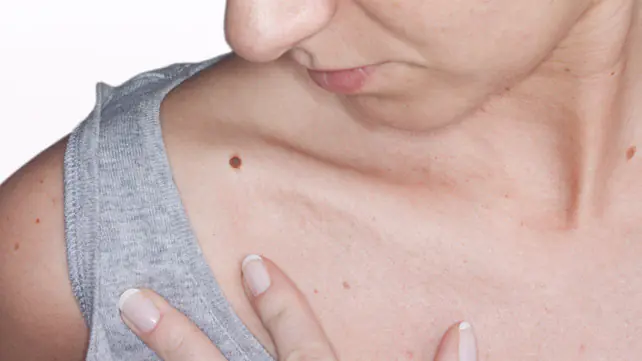
What are moles?
Moles are pigment spots of various sizes that can be congenital or develop in a person throughout life. The main “building” unit for such formations are melanocytes - epidermal cells containing a special coloring pigment called melanin.
Under the influence of injuries, prolonged exposure to direct sunlight, melanocytes are activated, resulting in dark spots appearing on the skin.
In most cases, spots appear in a child during the first 12 months of life - they are small in size and pale in color.
During puberty, they become larger and more pronounced, which can make a teenager dissatisfied with his appearance. Also, the number of formations rapidly increases during pregnancy or against the background of frequent exposure to ultraviolet rays.
If pigment spots appear on the surface of the face or open areas of the body, this can become a serious cosmetic defect. But the main danger is that they can degenerate into malignant formations - melanoma.
Causes for concern
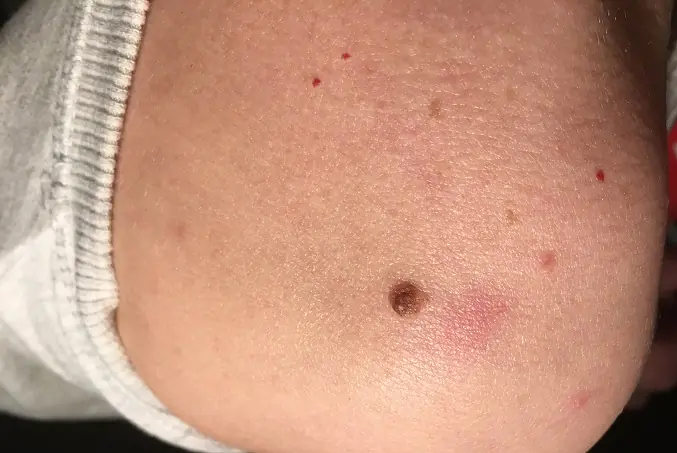
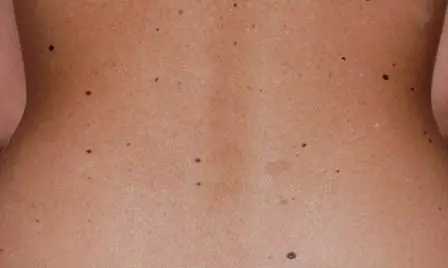
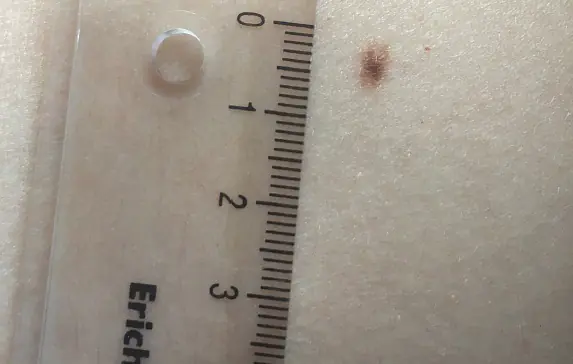
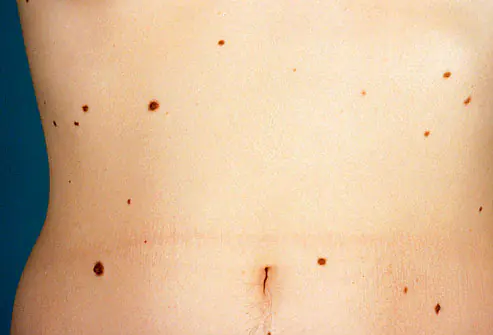

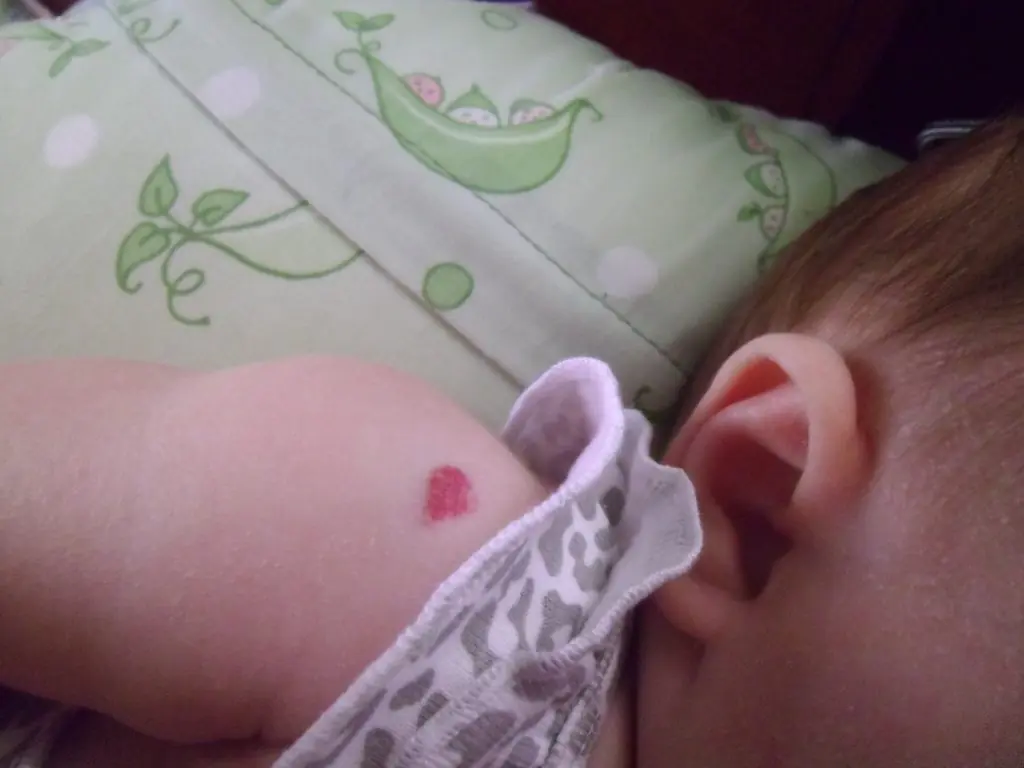
Many moles on the body or face are a completely normal phenomenon that does not require any treatment.
It is recommended to seek medical help and remove them in the following cases:
- the color of the formation changes;
- the edges of the mole become deformed and uneven;
- the pigment spot begins to hurt or bleed;
- there is itching or burning at the site of the lesion;
- the spot begins to quickly increase in size.
It is also best to consult a specialist if the rashes are located in areas where they can be easily damaged by clothing - neck, collarbones, palms, lower back. As a result of such injury, there is a possibility of infection, so it is recommended to remove the formation.
If the moles remain in their normal state and do not change their color or size, there is no cause for concern. The appearance of hairs growing from a nevus does not indicate degeneration into a cancerous formation, but it is strictly forbidden to pull them out yourself.
The only thing allowed if the presence of a hair causes discomfort is to carefully cut it off with scissors.
Reasons for appearance
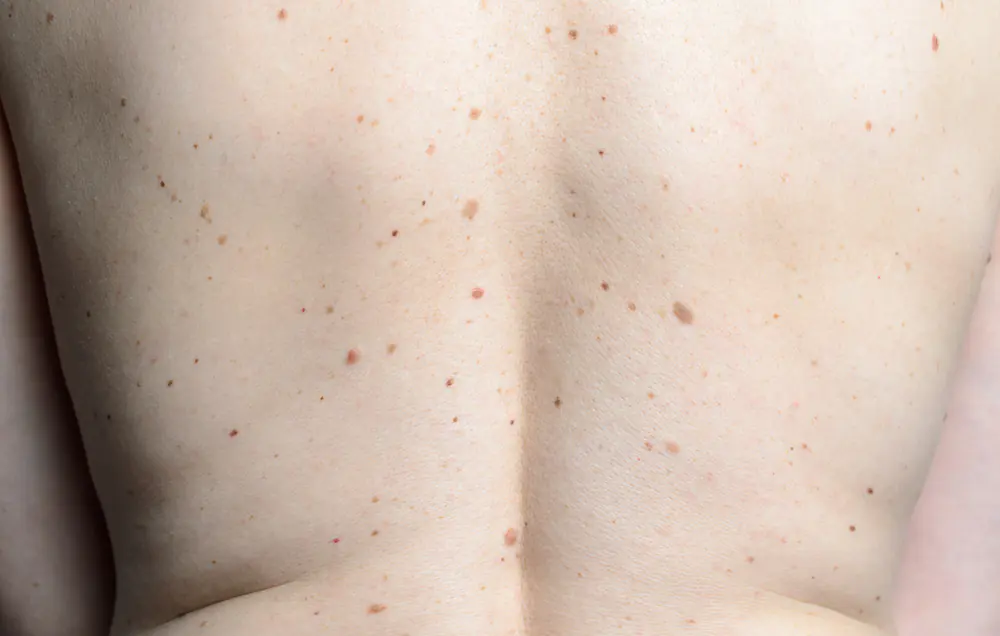
The main reasons for the rapid appearance of nevi on the surface of the face and body are conventionally divided into 2 main categories - internal and external.
Internal factors are represented by various injuries and diseases, external factors are represented by negative environmental influences.
A sudden appearance of moles can be caused by:
- Hormonal imbalance in the body - occurs while taking hormonal drugs, during puberty, menopause, and small moles often appear on the body during pregnancy.
- Hereditary factor - if the parents or one of them has a large number of rashes, most likely the child will also have this problem.
- Prolonged exposure to direct sunlight - nevi appear in the sun as a result of increased melanin production provoked by ultraviolet radiation.
- The process of natural aging of the epidermis and the whole organism.
- Allergic skin reactions.
- Contact with various chemicals.
- Among the external factors, insect bites stand out - mosquitoes and other blood-sucking insects leave behind long-term non-healing wounds, in the place of which pigment spots are formed.
In some cases, the reason that many small moles appear in a short time is a disruption in the functioning of internal organs - the large intestine, metabolic processes, and pancreas. Only a dermatologist can determine with maximum accuracy what a sharp increase in the number of rashes on the surface of the face and body means after all the necessary examinations.
Some men and women who have discovered many nevi on the stomach, back or any other part of the body turn to folk remedies based on iodine, celandine or other cauterizing components.
Under no circumstances should such preparations be used to remove age spots. This can not only provoke a severe burn and leave a deep scar, but also cause the formation of melanoma, that is, a malignant neoplasm.
Removal of nevi
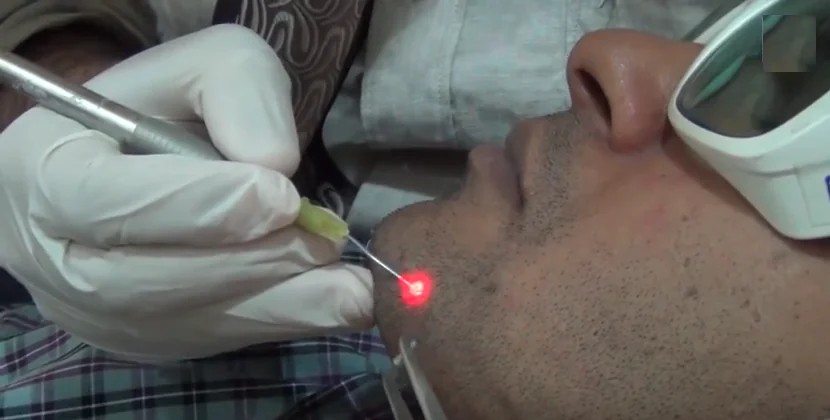
If a person has many moles on the face or body in a short time, it is best to consult a dermatologist to determine the exact cause of the changes.
The specialist will prescribe all the necessary tests and diagnostic measures to identify the origin and nature of the tumors, as well as select the optimal removal method.
Small moles are removed using modern methods:
- laser beam - allows you to target the area of the tumor without touching healthy areas of the skin; it is a painless and low-traumatic technology with a short recovery period;
- cryotherapy - removal using liquid nitrogen, which freezes the mole, promoting its death;
- classical surgery - elimination of formation using a surgical scalpel, is rarely used, since deep scars and cicatrices often remain on the skin after surgery;
- radio waves – the procedure involves the use of a so-called “radio wave knife”, accompanied by rapid recovery and no risk of infection;
- electrocoagulation - the use of electric current, after which the formation completely dries out and dies, leaving no scars or marks.
The decision that this formation on the surface of the epidermis needs to be removed can only be made by a doctor. In case he decides to keep them, the patient is advised to visit a dermatologist and oncologist for regular preventive examinations.
Preventive measures

In order to prevent the appearance of new formations on the skin of the face and body, you need to try to limit as much as possible the factors that can cause them.
Avoiding prolonged exposure to direct sunlight and visiting a solarium will help stop the process of nevi appearing. This will slow down the production of melanin and they will appear much less frequently.
People prone to frequent formation of rashes and age spots are recommended to use sunscreens with a high ultraviolet filter. Clothing made of dense materials that covers the skin is effective protection from sun rays. To protect your face, you should wear a wide-brimmed hat.
Conclusion
Doctors warn! Shocking statistics - it has been established that more than 74% of skin diseases are a sign of parasite infection (Accarida, Giardia, Toxocara). Worms cause enormous harm to the body, and the first to suffer is our immune system, which should protect the body from various diseases. The head of the Institute of Parasitology shared the secret of how to quickly get rid of them and cleanse your skin, it turns out that’s enough. Read more .
An increase in the number of moles is a common occurrence and should not be a cause for concern. An alarming sign is a change in the normal color or size of the nevus, pain, itching, burning, and the appearance of bloody discharge. In such cases, you should immediately consult a doctor to remove the formation.



